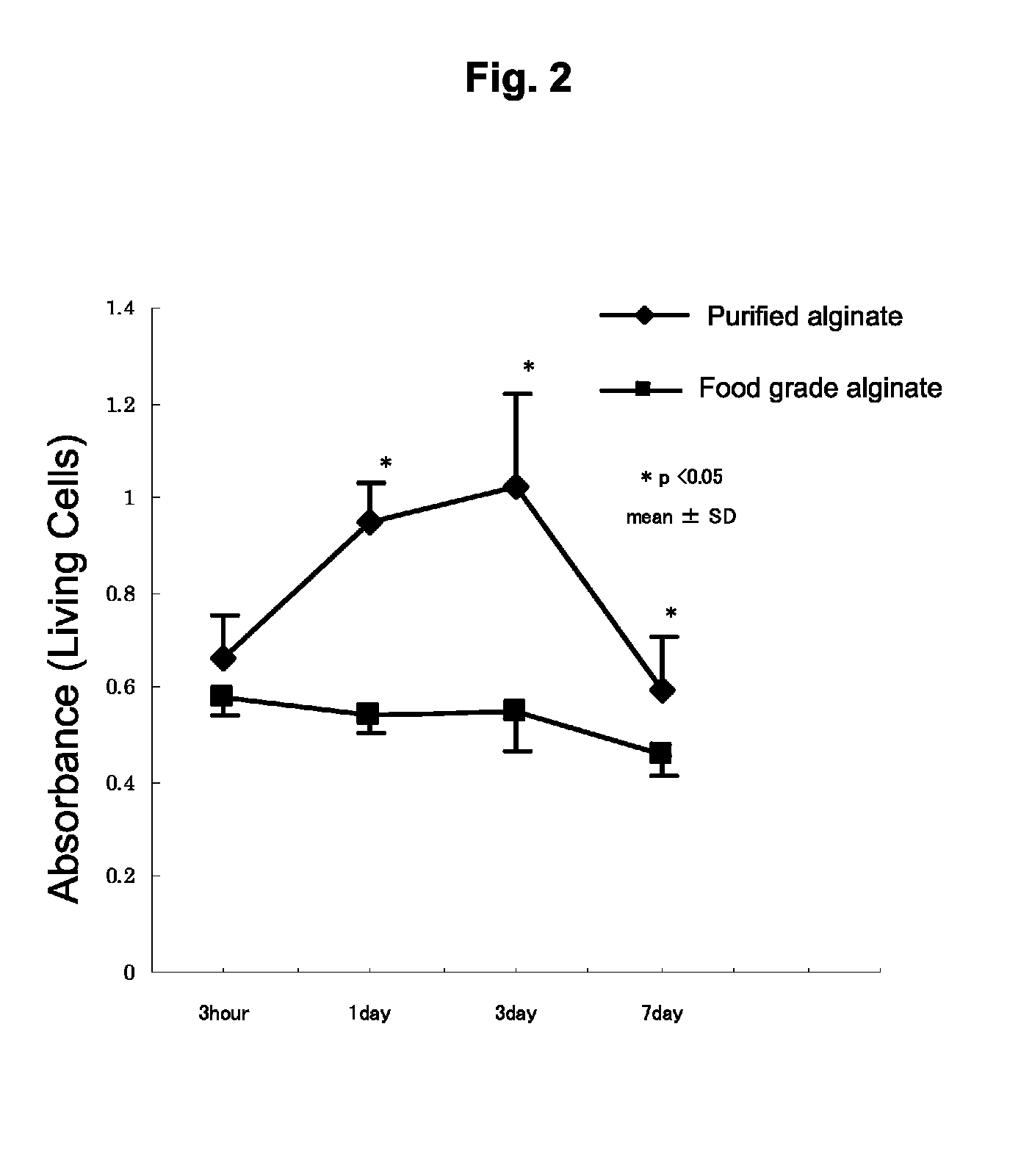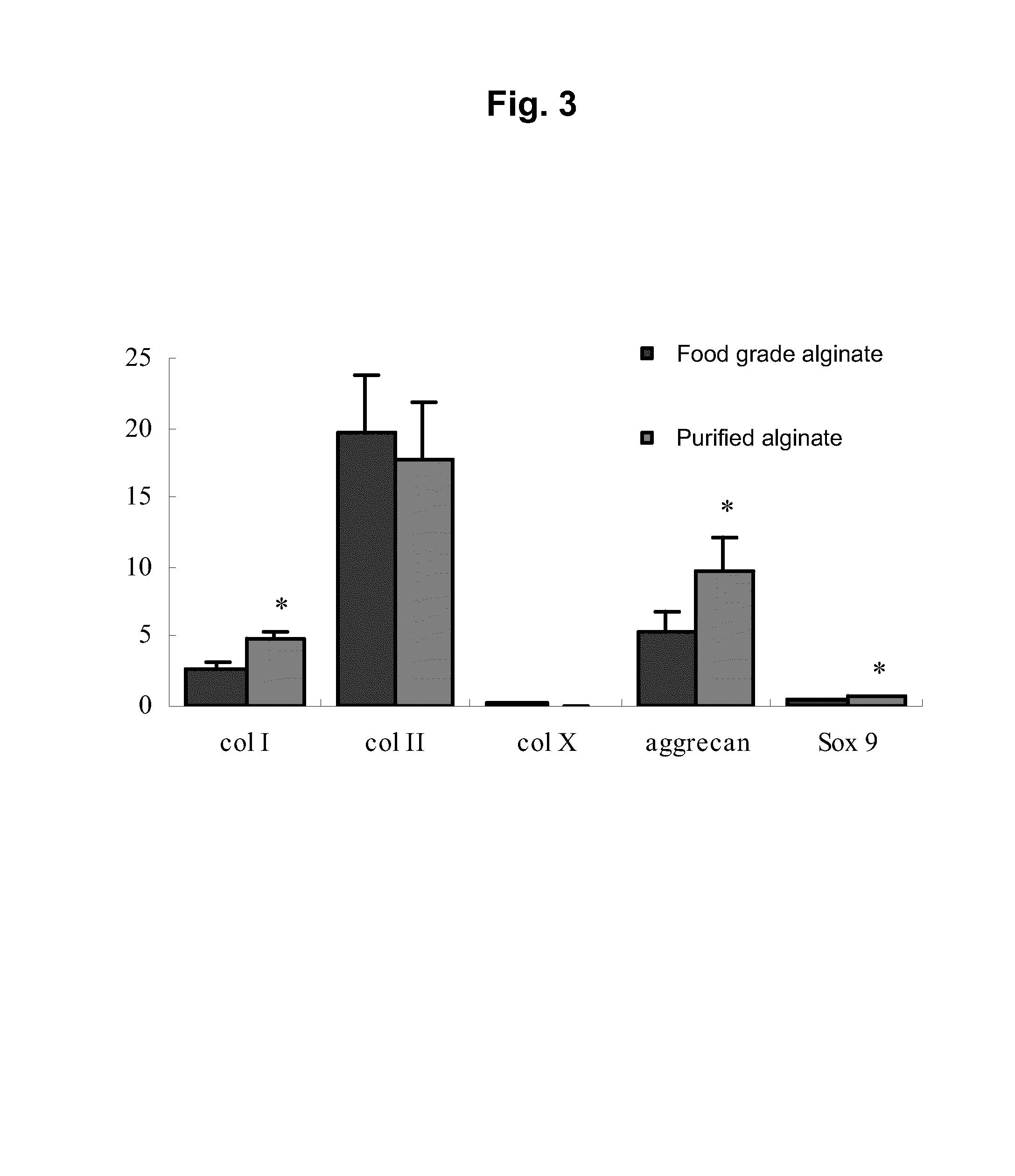Compositions and methods for treating cartilage disease
a cartilage disease and cartilage technology, applied in the direction of drug compositions, skeletal/connective tissue cells, prostheses, etc., can solve the problems of virtually no potential for self-repair, inadequate repair of cartilage defects, and lack of vascular and neural networks of articular cartilage, so as to improve the lubricating function of joints, promote effective cartilage regeneration, and improve the effect of lubricating function
- Summary
- Abstract
- Description
- Claims
- Application Information
AI Technical Summary
Benefits of technology
Problems solved by technology
Method used
Image
Examples
example 1
Preparation of Sodium Alginate Solution
[0151]In the present example, two types of sodium alginate were used consisting of purified sodium alginate (Kimica Corp., Mochida International Ltd., Sea Matrix (sterilized), Serial No. B5Y01) and non-purified, food grade sodium alginate (also referred to as commercial grade sodium alginate, Wako Pure Chemical Industries, Ltd., Sodium Alginate 500, 199-09961). The purified sodium alginate was sterilized and freeze-dried. The food grade sodium alginate was sterilized by filtering with a filter having a pore diameter of 0.22 μm.
[0152]When endotoxin levels were measured using a commercially available LAL assay kit (Limulus Color KY Test Wako, Wako, Japan), the endotoxin level of the purified sodium alginate was 5.76 EU (endotoxin units) / g and that of the food grade sodium alginate was 75950 EU / g, thus indicating that the endotoxin level of the purified sodium alginate was far lower than that of the food grade sodium alginate. Namely, the purified...
example 2
Production of Transplant Cells
[0160]Bone marrow mesenchymal stromal cells (BMSC) were isolated and cultured to obtain transplant cells. BMSC include erythropoietic cells and the like in addition to bone marrow mesenchymal stem cells. 1 mL of bone marrow were harvested from the tibia of four-month-old Japanese white rabbits followed by washing twice with Ca—Mg-free PBS (Gibco BRL Lab.) and suspending in DMEM-High Glucose (DMED-HCA Sigma Chemical, St. Louis, Mo.). Blood clots were removed with a cell strainer having a pore diameter of 70 μm (Falcon Co., Ltd.). The cells were then incubated while humidifying at 37° C. and 5% CO2 in a 100 mm culture dish containing a culture medium consisting of DMEM-HG, 10% fetal bovine serum (FBS, Gibco, Life Technology, Grand Island, N.Y.) and 1% antibiotics (Penicillin-Streptomycin-Fungizone 100× concentrated, Cambrex Biosciences, Walkersville, Md.). The culture medium was replaced every three days and non-adherent cells were removed. After monolaye...
example 3
Production of Alginate Beads
[0161]The cells obtained in Example 2 were suspended at 2.5×107 cells / ml in a sodium alginate solution adjusted to a concentration of 2% w / v with filtration-sterilized Milli-Q water. The suspension was gelled by dropping into CaCl2 solution with a pipette, and after washing for two times the microcapsules that formed 10 minutes later with Ca—Mg-free PBS, the microcapsules were washed once with DMED-HG. The resulting beads contained 1×106 cells per 40 μl per bead.
[0162]The cells were harvested from the alginate beads by washing three times with PBS and incubating at 37° and 5% CO2 in 50 mM EDTA (Gibco BRL Laboratories) followed by centrifuging for 5 minutes at 1500 g 10 minutes later to harvest the cells.
PUM
| Property | Measurement | Unit |
|---|---|---|
| viscosity | aaaaa | aaaaa |
| viscosity | aaaaa | aaaaa |
| viscosity | aaaaa | aaaaa |
Abstract
Description
Claims
Application Information
 Login to View More
Login to View More - R&D
- Intellectual Property
- Life Sciences
- Materials
- Tech Scout
- Unparalleled Data Quality
- Higher Quality Content
- 60% Fewer Hallucinations
Browse by: Latest US Patents, China's latest patents, Technical Efficacy Thesaurus, Application Domain, Technology Topic, Popular Technical Reports.
© 2025 PatSnap. All rights reserved.Legal|Privacy policy|Modern Slavery Act Transparency Statement|Sitemap|About US| Contact US: help@patsnap.com



